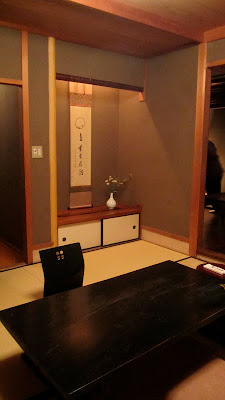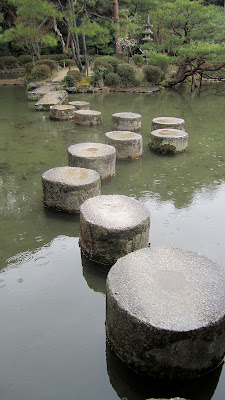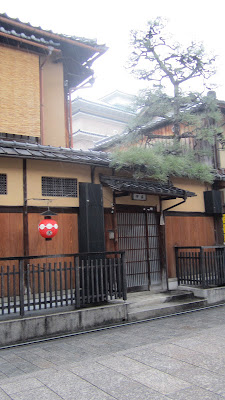One of the things that makes the ryokan we stayed at in Kyoto famous, is its use of the coveted Yuzu fruit in their dishes, and even in their baths. In fact the name of the ryokan is Yuzuya Ryokan. It's located right next to the Yasaka Shrine, also known as the Gion shrine.
Yasaka Shrine
Russell and I had never heard of a Yuzu. It sounded kinda dirty to us. Hey, I can see your Yuzu. But it's not dirty at all. It's actually a citrus fruit. Think lemon, lime and tangerine all in one yummy, sweet, fruit. It looks like a fat, yellow, orange. They're delicious. I think I need a tree. In fact I know I do.
Entrance to the Ryokan
The funny thing is, on our walk during the day we had actually passed the entrance to our ryokan. I even took a picture of it thinking, what a lovely stone path, treacherous, but lovely. I wonder what it is? Lo and behold, several hours, and miles later, it turned out to be our ryokan.
Good thing Russell is carrying the luggage.
The entrance was dark but strangely inviting. Kind of like an opium den, except the drug here was Yuzu.
The coveted Yuzu.
A young woman in traditional Japanese garb led us to our room at the top of the steep stairs. What is it with the steep stairs? Geez. We had been asked to remove our shoes and put on the house slippers provided. Ok, I have small feet like the Japanese, but slippers and I don't agree. They kept flipping off my feet. The steep stairs were like a death trap for me. I decided to go it in my socks.
Nice branch. Is that the welcome branch?
Russell studied the evacuation plan posted in our room like he does at every hotel we stay at. But not to find out where the nearest exit is. He does it to find out how are room compares to others. The evacuation plan always includes a map outlining the floor plan. He was delighted to learn we had one of the largest rooms.
It was exactly what I imagined a ryokan would be like, right down to the cedar bath tub and soji screens. The only thing missing was a garden view. Russell explored the room tatami mat to ceiling, opening drawers and looking in closets. "Hey, there's a safe." He pulled back one of the soji screens to reveal a view of a parking lot below. "Close the screen! Close the screen," I exclaimed. "You're ruining the allure." Geez. I need sake now.
Our room - pre bed.
A few minutes later there was a knock on the door and some complimentary tea was brought in. A nice touch I thought. We smiled and asked if she could bring in a couple of sake glasses. We wanted to see if the sake we bought was as pretty as the packaging. She brought us water glasses. Wow! She recognizes heavy drinkers when she sees them. Sake's just not the same in a water glass.
After Russell tried the traditional Japanese shower, i.e., sitting on a tiny bench with a handheld showerhead and a bucket, and I partook of the cedar bath with yuzu, we dressed in the yukata and jacket provided, otherwise known as "dressing for dinner."
Now most traditional ryokans serve you a kaiseki meal in your room. This one however had a beautiful dining room with a traditional Japanese viewing garden with waterfall, so guests were asked to come down for both meals: breakfast and dinner.
Can you see my yuzu now?
The dinner was superb! Russell was enamored with all the unique touches, not to mention, the amazing flavors. A true kaiseki meal is a reflection of the season, emphasizing the freshest ingredients and utilizing utensils and pottery which reflect the mood and essence of the period, in this case early Spring.
Appetizer board.
Look how beautiful this is.
That's a sakura (cherry) twig about to blossom.
A single broad bean, a sliver of fresh ginger on top of a mini,
and I mean mini, crab cake with a yolk smear.
Three kinds of sashimi.
Russell was completely enamored with the sashimi course. Yes, the fish was melt in your mouth great. But he was astounded by how it was served. Under the rice paper, he discovered a thin sheet of ice, which was used to keep it cold. It was like he had found gold, he was so delighted. "But it's ice, look, it's ice," he kept exclaiming over and over. "I know, I know. Have another glass of sake."
He had to find out how they made it. "We gotta do this at home!" Uh, huh, good luck with that. Turns out they special order it from the ice house. I have to admit it was rather cool. I'm happy if I can find crushed ice for margaritas.
Russell's ice sheet.
Most of the courses had some form of yuzu in the preparation. When they brought us the Kobe beef with a little bit of spicy yuzu relish, we were smitten. Thankfully they sell the relish so of course we bought a jar.
So yuzu, so good.
The next course was the traditional Kyoto dish, yudofu, which is seasonal vegetables and tofu simmered in a pot table-side. Theirs had a twist. It came with...wait for it... yuzu, as well as, fish. Now, Russell is not really a tofu man, but he loved it.
Yuzu, greens and fillet-o-fish
It's as pretty as it is delicious
We were pretty much full after that but it didn't stop us from eating the next delicious course, which was steamed rice, cooked at your table in a traditional rice crock, with, you guessed it, yuzu. It was so aromatic, it made us hungry all over again.
Rice cooking table side. After ten minutes the rice was cooked
perfectly and infused with the uniquely fragrant yuzu flavor. Yummy.
After dinner I stopped at the public bath. They can't call it an onsen because it's not from a hot spring. It was a large cedar bath, family size, with fresh yuzu scenting the water. It wasn't very private either. If you were inquisitive, or happened to be walking by, you could probably get a glimpse of a naked woman or man, depending upon which curtain, yes curtain, not door, you glanced through. I didn't care. I'd had two bottles of sake and even more yuzu.
It was so awesome to slip into the steaming water, the scent of yuzu permeating my senses. That's it - I have been properly yuzu-ed I thought. It suddenly occurred to me, Thank God I'm not allergic to citrus, I'd be dead by now.
Yuzu bath. Feel the burn.
When I got up to our room, the fluffy bed rolls lay beckoning. Russell was excited by the little lantern they put out. It would be even more delightful if it were lit by candles but that would be a major fire hazard.
Comfy.
The futon bed, and not like futons in America, more like a thick bed roll, were more comfortable than I thought they would be. The sake could have helped, Russell offered.
We dressed for breakfast. I was a little concerned. I've tried the traditional Japanese breakfast which consists of a runny gruel called Okayu (rice porridge) and sometimes fish. I'm not a fish for breakfast kind of person.
But their breakfast was great. Sure there was fish. And there was kind of a rice porridge, cooked at the table no less, but it was really good.
First a tray with several small morsels were provided. They consisted of things like tender bamboo shoot, a couple of beans, a vegetable roll and dishes of Tsukadani or fish preserved in soy sauce. In the old days, people who lived in inland provinces dried all kinds of food with soy sauce. The soy sauce preserved the food so that people could eat through the winter. I learned about this on a tour I took to Shibamata. Money well spent.
Dried or not it was all good.
The platter-o-food was also served with a plate of grilled fish, tamagoyaki slices (sweetened egg omelette) and the omnipresent - Japanese pickle, plus a crock of steamed rice.
But wait there's more. Well, you won't ever go hungry at this ryokan I mused. A boiling crock of miso soup was brought to the table as well. The soup was hearty and had beefy chunks of root vegetables like carrots and lotus roots.
Can I get a to go carton?
Grilled fish, sweet egg omelet and pickles.
A pregnant woman must have invented this combo.
Where's the peanut butter?
Crock-o-rice
The only thing they didn't serve enough of was the pure yuzu juice. We only received half a glass. They must have run out since so much of it was served in the food.
Thank you, can you fill my glass up, please?
And then, of course, there was tea...with yuzu. At this point I can say I was officially yuzued out. So I asked for coffee instead.
Yuzu tea.
This cup may be too feminine for Russell, metro-sexual or not.
These are old school rice makers. No, seriously. I asked.
It was a great experience and now I can say I have stayed at a ryokan and experienced yuzu in every way. Hey, that sounds dirty. Oooops.






























































